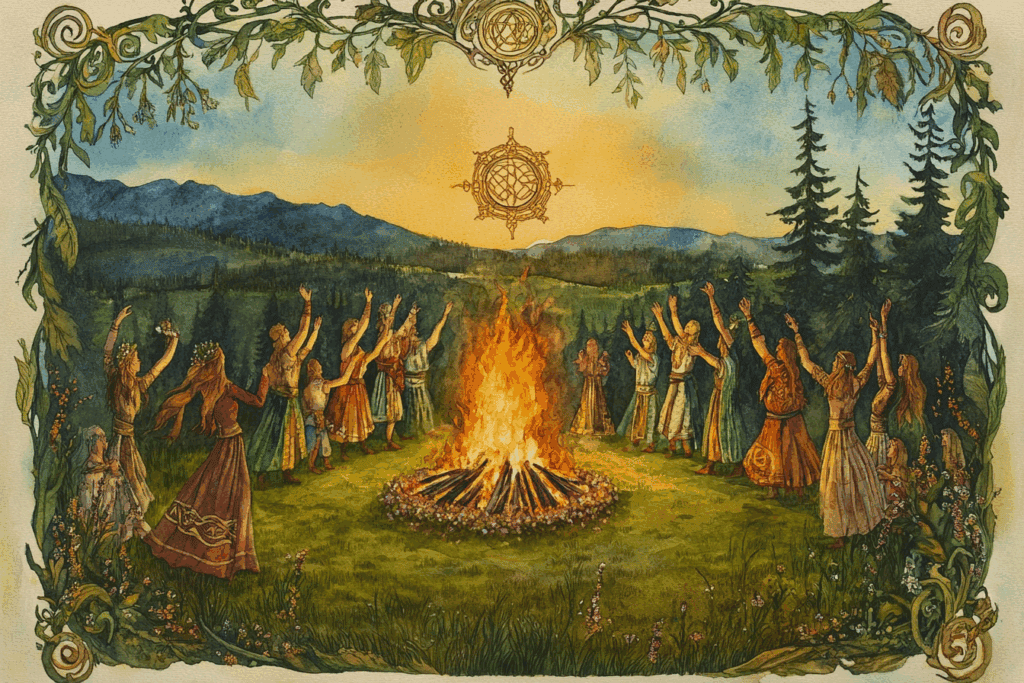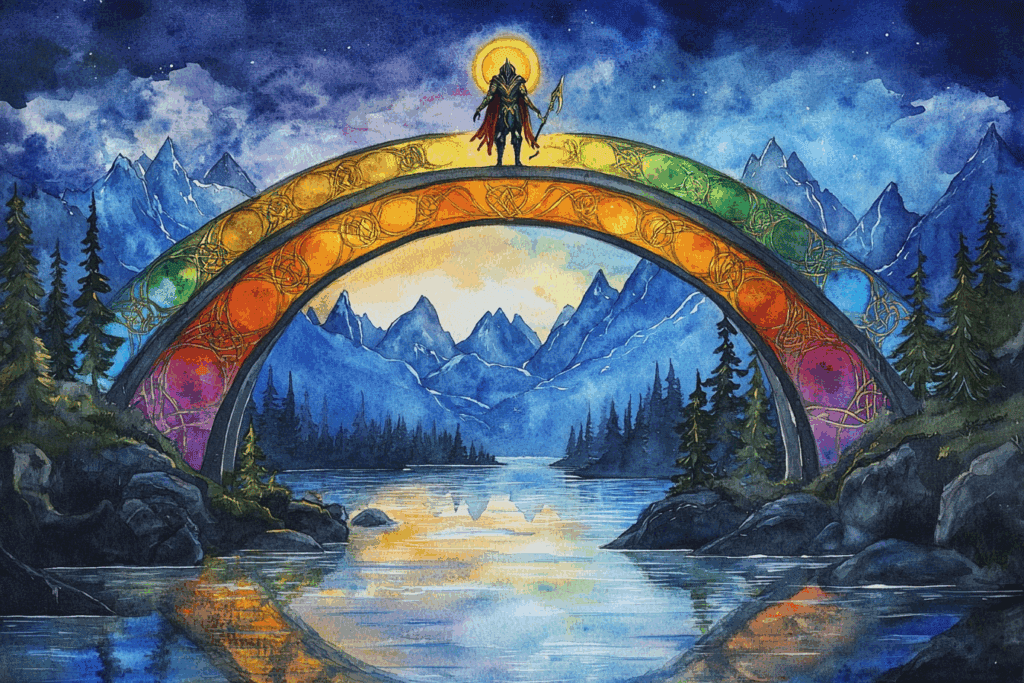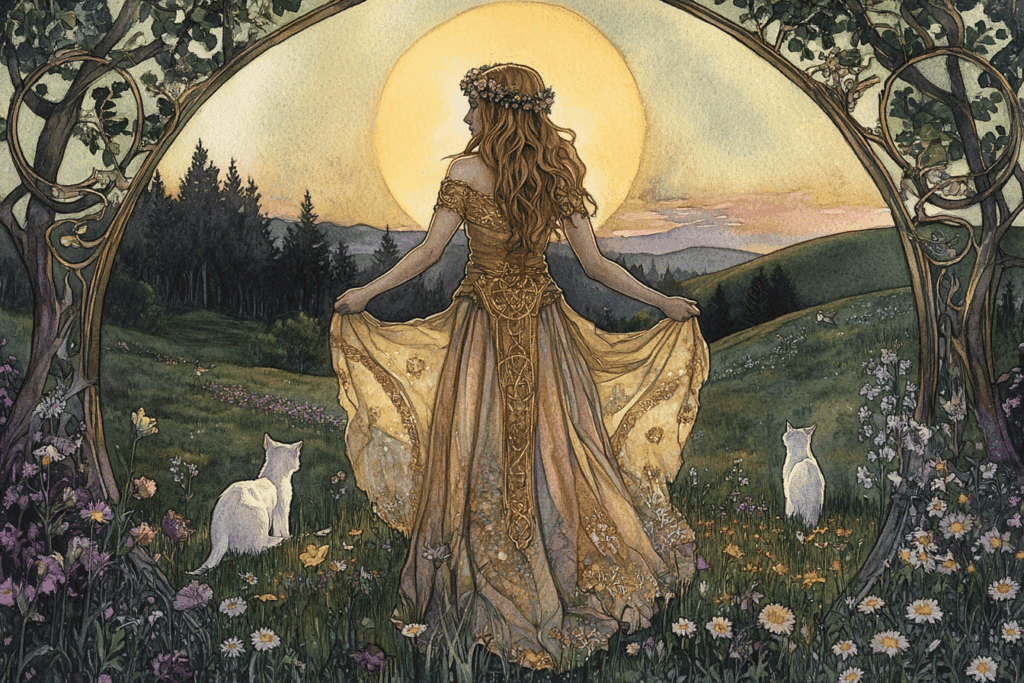No products in the cart.
June 11, 2025 5:35 am
June 11, 2025 5:35 am
The summer solstice, known as the longest day of the year, holds profound significance in both natural cycles and ancient belief systems.
In Norse mythology and broader Nordic tradition, this celestial turning point is marked by vibrant midsummer celebrations, blending pagan rituals, communal gatherings, and reverence for the power of the sun.
From bonfires in Norway to fertility rites in Sweden, the summer solstice is far more than a seasonal event—it is a sacred threshold in the mythic imagination of Scandinavia.

In the Nordic countries, midsummer—also known as John’s Day or Midsummer Day—has long been known as a national holiday and festivity deeply rooted in both Christian and pagan traditions.
According to anthropologist Sir James George Frazer in his influential work The Golden Bough, midsummer fire-festivals were common across Europe but held particularly strong associations with the solstice in Scandinavia.
In Norway and Sweden, bonfires were lit on hilltops, open spaces, and even floated down rivers on rafts to ward off evil spirits (Frazer, 1922, pp. 160-172).
These solstice traditions, often celebrated on June 23rd or 24th, coincide with the astronomical summer solstice and were believed to offer protection, fertility, and the potential for magical transformation.
Anthropologist Frazer writes of the “midsummer fires” that were thought to protect homes and fields, suggesting that their origins date back long before Christian influence attached the festival to St. John the Baptist.
Grenville Pigott, in A Manual of Scandinavian Mythology, links the summer solstice directly to the mythic death of Baldr, the fair and gentle Norse god associated with light and beauty.
Pigott notes that the month stretching from May 21st to the summer solstice was dedicated to Baldr, and that the shortening of days following midsummer symbolized his death at the hands of the blind god Höðr (Pigott, 1839, p. 40).
The eighth solar house, beginning at the solstice, is linked with Heimdall, the celestial watchman who stands on the rainbow Bifröst.
Heimdall is described as the whitest of the Æsir, whose shining nature corresponds with the sun at its highest elevation (Pigott, 1839, p. 40).
In midsummer’s golden light, Heimdall watches over the worlds—a luminous guardian during a time of heightened spiritual activity and fertility.

Bertha Surtees Phillpotts, a philologist and scholar of Norse literature, details how midsummer rituals in Scandinavia often revolved around symbolic marriages, sacrifices, and the celebration of abundance.
She describes a “ritual marriage” wherein a man would impersonate a god and fight for his bride, often symbolizing the union of human and divine forces tied to the fertility of the land (The Elder Edda and Ancient Scandinavian Drama, Phillpotts, 1920, pp. 119-131).
In Sweden, she notes the tradition of the “May-Lord” winning a bride and leading celebrants in song and festivity.
Phillpotts also recounts midsummer celebrations in Gotland, where the bridegroom would be crowned with flowers to represent fertility and renewal.
This blend of dramatic performance and mythic reenactment exemplifies the ways pagans would carry out certain rituals to invoke the power of the sun and ensure a fruitful harvest.
The act of lighting a bonfire on midsummer eve was more than celebration—it was a spiritual practice.
In The Golden Bough, Frazer recounts that even as late as the 19th century, Norwegians believed that the flames banished sickness and evil spirits.
The fires were often kindled in honor of St. John, but their roots clearly go back to pre-Christian solar worship (Frazer, 1922).
Scandinavian people believed that the solstice—when the sun rises highest and remains longest in the sky—was a time when magical powers during the solstice were strongest.
The summer solstice traditions in Iceland and across Scandinavia emphasize the idea that the veil between the worlds was thinner during this period, enabling a deeper connection with the divine and the spirits of nature.

Midsummer in Norway, known locally as Sankthans, is a national holiday in Norway where Norwegians gather to celebrate with food, music, and bonfires.
The holiday in Norway is not only a time to enjoy the midnight sun but also to participate in rituals and customs that date back to the Viking Age.
In Iceland, the celebration has taken on both Christian and pagan elements.
The country’s famed Secret Solstice music festival nods to this duality. Icelanders are more superstitious during the solstice, believing in increased spiritual activity and the influence of hidden folk (huldufólk).
It’s considered a great time to visit Iceland, as locals spend their midsummer enjoying the outdoors, surrounded by the power of the sun and the beauty of the natural world.
The solstice celebration connects deeply to Norse pagan belief. The Norse gods of fertility, such as Freyr and Freyja, were believed to be most active during the summer.
Celebrated throughout the Nordic, these deities were honored with offerings and dance.
Pagan holidays like the midsummer festival were tied to agricultural cycles and fertility rituals, marking the importance of light and growth.
The poet Snorri Sturluson also mentions solstice-related festivities in the Prose Edda, which underscores their significance in old Norse religion.
While not always explicitly dated, certain rituals during midsummer—such as the burning of Baldr’s effigy—indicate the mythological weight given to this seasonal turning point.

In modern Scandinavia, midsummer has evolved into a national holiday with strong cultural and historical resonance.
Midsummer was celebrated with maypoles decorated with flowers, dances around open fires, and food and drink to celebrate.
The day celebration continues to echo themes of abundance, love, and cosmic balance.
The shortest night of the year, or midsummer’s eve, remains a symbolic juncture.
It is known as midsummer and regarded as a time when one can ward off evil spirits, connect with ancestors, and drink to celebrate the solstice.
From Sweden and Finland to Norway and Iceland, midsummer traditions are enduring reminders of the ancient connection between the Nordic people and the cycles of the sun.
The summer solstice celebration is a profound example of how myth, ritual, and season intertwine in Norse and Nordic tradition.
From the bonfires that blaze against the midnight sun to the symbolic weddings and fertility rites, midsummer is a moment of powerful liminality.
As James George Frazer, Grenville Pigott, and Bertha Surtees Phillpotts each observed, the solstice is more than a date on the calendar.
It is a mythic moment when the sun speaks, the earth awakens, and the people of the North celebrate life at its brightest.
Whether you find yourself in a quiet fjord in Norway, a festive summer home in Sweden, or watching the sun rise over Iceland’s horizon, remember that you walk in the footsteps of Norse ancestors who once celebrated the midsummer sun with reverence, fire, and joy.